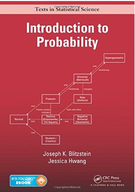Solution Found!
An election is being held. There are two candidates, A and B, and there are n voters
Chapter 9, Problem 52(choose chapter or problem)
An election is being held. There are two candidates, A and B, and there are n voters. The probability of voting for Candidate A varies by city. There are m cities, labeled 1, 2,...,m. The jth city has \(n_{j}\) voters, so \(n_{1}+n_{2}+\cdots+n_{m}=n\). Let \(X_{j}\) be the number of people in the jth city who vote for Candidate A, with \(X_{j} \mid p_{j} \sim \operatorname{Bin}\left(n_{j}, p_{j}\right)\). To reflect our uncertainty about the probability of voting in each city, we treat \(p_{1} \ldots \ldots, p_{m}\) as r.v.s, with prior distribution asserting that they are i.i.d. Unif(0, 1). Assume that \(X_{1}, \ldots, X_{m}\) are independent, both unconditionally and conditional on \(p_{1}, \ldots \ldots, p_{m}\). Let X be the total number of votes for Candidate A.
(a) Find the marginal distribution of \(X_{1}\) and the posterior distribution of \(p_{1} \mid\left(X_{1}=k_{1}\right)\).
(b) Find E(X) and Var(X) in terms of n and s, where \(s=n_{1}^{2}+n_{2}^{2}+\cdots+n_{m}^{2}\).
Questions & Answers
QUESTION:
An election is being held. There are two candidates, A and B, and there are n voters. The probability of voting for Candidate A varies by city. There are m cities, labeled 1, 2,...,m. The jth city has \(n_{j}\) voters, so \(n_{1}+n_{2}+\cdots+n_{m}=n\). Let \(X_{j}\) be the number of people in the jth city who vote for Candidate A, with \(X_{j} \mid p_{j} \sim \operatorname{Bin}\left(n_{j}, p_{j}\right)\). To reflect our uncertainty about the probability of voting in each city, we treat \(p_{1} \ldots \ldots, p_{m}\) as r.v.s, with prior distribution asserting that they are i.i.d. Unif(0, 1). Assume that \(X_{1}, \ldots, X_{m}\) are independent, both unconditionally and conditional on \(p_{1}, \ldots \ldots, p_{m}\). Let X be the total number of votes for Candidate A.
(a) Find the marginal distribution of \(X_{1}\) and the posterior distribution of \(p_{1} \mid\left(X_{1}=k_{1}\right)\).
(b) Find E(X) and Var(X) in terms of n and s, where \(s=n_{1}^{2}+n_{2}^{2}+\cdots+n_{m}^{2}\).
ANSWER:Step 1 of 3
Given data:
An election is being held. There are two candidates, A, and B, and there are n voters. The probability of voting for candidate A varies by city. There are m cities, labeled 1, 2, 3…..m. The jth city has nj voters, so, \(n_{1}+n_{2}+n_{3}+\ldots \ldots \ldots \ldots+n_{m}=n\).
Let \(X_{j}\) be the number of people in the jth city who vote for candidate A, with \(X_{j} \mid p_{j} \sim \operatorname{Bin}\left(n_{j}, p_{j}\right)\) .
